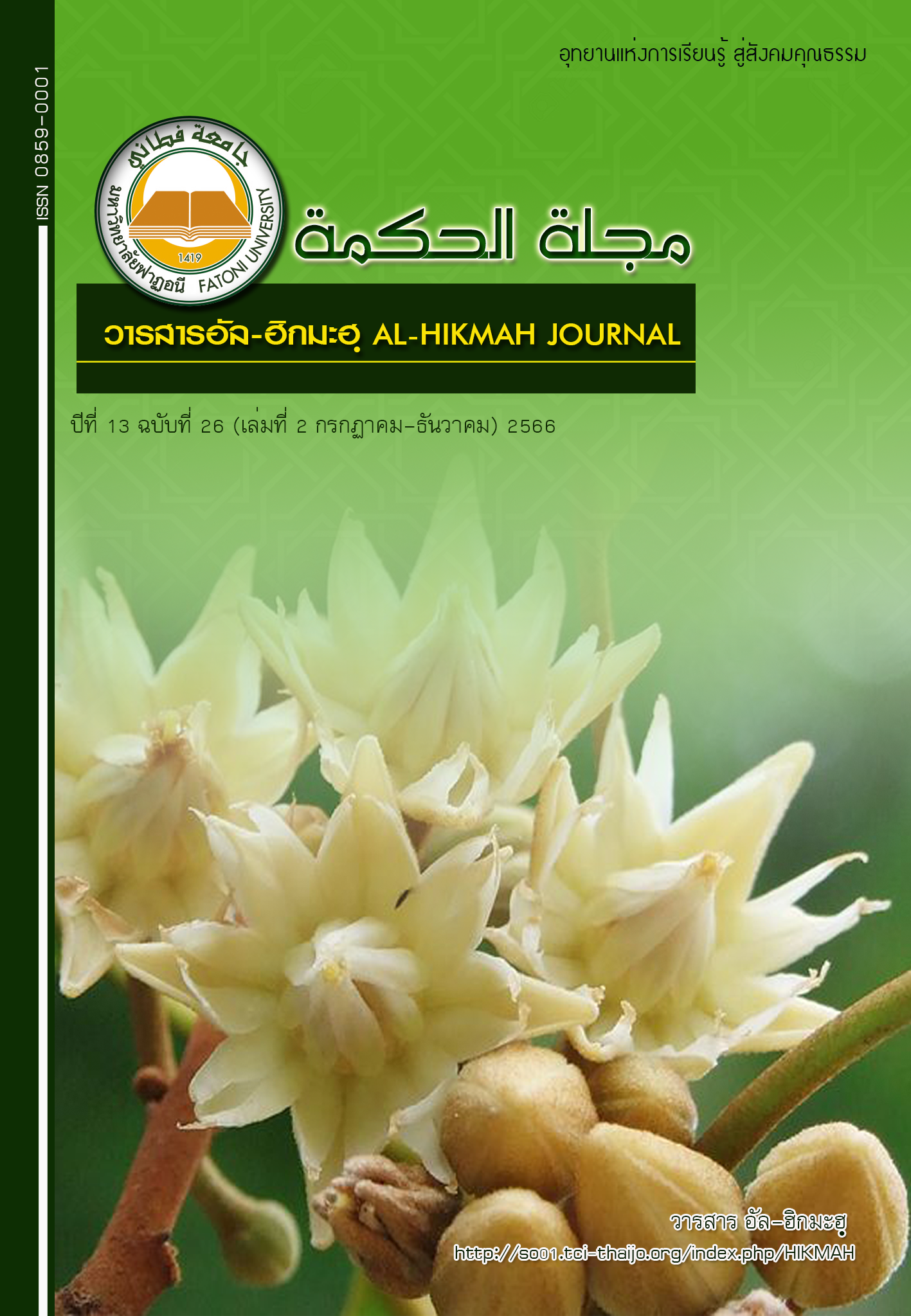GUIDELINES FOR VALUE CHAIN MANAGEMENT PROMOTION OF PROCESSED PRODUCTS STINGLESS BEE HONEY TO COMPETITION OF STINGLESS BEE HONEY FARM WOMEN GROUP, BAN PONGYAWI, BUDI SUB-DISTRICT, MUEANG YALA DISTRICT, YALA PROVINCE
Keywords:
manage the value chain, processed products, stingless-bee , honey housewife farmer groupAbstract
Abstract
This study aims to study and analyze the value chain management problems of processed products from stingless-bee honey, then solve the problems and propose ways to promote value chain management of processed products from stingless-bee honey for developing the competitive skills of a stingless-bee honey farmer's group, Ban Phongyawee, Budi Sub-district, Muang District, Yala Province. This survey study was considered mix-method research, employed both quantitative and qualitative data through the questionnaires, group discussions and in-depth interviews as tools. The sample group were 400 consumers whose general information of the samples was mostly female, aged between 20-30 years, single, Muslim with a bachelor's degree. They were mostly farmers with the average monthly income around 5,001-10,000 Baht. The group discussion procedure has been involved by the policy executives, practitioners, academics, farmers, producers, distributors, and consumers of processed products from stingless-bee honey, 7 people in total. The analysis of packaging characteristics showed that most consumers believed that the size of the soap comes in two sizes, 50 grams and 100 grams, and the packaging was appropriate and beautiful. In terms of degradation, the packaging was paper box, not toxic to the environment. This was consistent with the results from the group discussion, agreed that the packaging size should be 50 grams and 100 grams because it was the size of soap that consumers prefer to use, and proposed making a small trial soap for distribution to customers to build consumer awareness. Also, the analyzed results about the composition of the product that affects the decision to buy stingless-bee honey bar soap revealed that the potential aspect had the greatest influence on purchasing decisions which was consistent with the results from the focus group discussion, agreed that the product potential aspect was that the product should be certified by the standard mark in production .To gain insight, the researcher conducted an in-depth interview, asking the bee farmer groups, the groups of housewives, producing honey bar soap, retail stores and government agencies by using the concept of value chain management to study, and it was found that the upstream problem was the limited quantity of stingless bee breeding. In addition, it was difficult to control the quality of raw materials. The midstream problem was lack of standards in production, and knowledge about standardized product design. The downstream part was the farmers' housewives’ group, lacking marketing and public relations knowledge. The solution to the upstream problem is that the bee farm standards should be established. Government officials from relevant agencies need to provide knowledge and training on bee diseases and bee farm standards. As for the solution to midstream and downstream problems, knowledge transfer to farmers' groups by bringing scientific knowledge combined with local wisdom to produce products with more quality and variety. The online marketing such as Tiktok, Shopee, Lazada are needed to promote sales to expand market opportunities to a wider group of customers which has been previously continually supported. However, there were still problems and obstacles in the implementation which might be due to lack of monitoring or evaluation. Therefore, there should be an evaluation of the performance to increase the value of processed products, which must cover all dimensions from upstream, midstream, and downstream by comparing the increased value and the overall picture can help the farmers' housewives group for further sustainability.
References
กองพัฒนาเกษตรกร กรมส่งเสริมการเกษตร. (2560). คู่มือการจัดตั้งและดำเนินงานกลุ่มแม่บ้านเกษตรกร. กรุงเทพฯ: โรงพิมพ์ชุมชนสหกรณ์การเกษตรแห่งประเทศไทย จำกัด.
จิระเดช มณีรัตน์ และอัญชลี สวาสดิ์ธรรม. (2554). การคัดเลือกชนิดของน้ำผึ้งเพื่อผลิต ผลิตภัณฑ์ลูกกวาด. ปทุมธานี: คณะเทคโนโลยีการเกษตร มหาวิทยาลัยเทคโนโลยีราช มงคลธัญบุรี.
นิรันดิ์เกียรติ ลิ่วคุณูปการ. (2565). การจัดการห่วงโซ่คุณค่ากลุ่มวิสาหกิจชุมชนผลิตภัณฑ์เกษตรแปรรูป ในพื้นที่จังหวัดชายแดนใต้. วารสารมหาวิทยาลัยราชภัฏยะลา. (17),1 136-146.
นิศา ชูโต. (2551). การวิจัยเชิงคุณภาพ (พิมพ์ครั้งที่ 4 ). กรุงเทพฯ:บริษัท พริ้นโพร จำกัด
นัย บำรุงเวช. (2562). รู้จัก “ชันโรง” ผึ้งจิ๋ว ตัวช่วยขั้นเทพเกษตรกร. [ออนไลน์]. ค้นเมื่อ 2 มิถุนายน 2566, จาก https://www.technologychaoban.com/agricultural-technology/article_15954
นุกูล ชิ้นฟัก, วรลักษณ์ ลลิตศศิวิมล, สมจิตร ยิ้มสุด, ถาวร ไชยมะโณ และประวีณ เลิศอริยะพงศ์กุล. 2564. การจัดการความรู้การเลี้ยงชันโรงเพื่อสร้างอาชีพทางเลือกตามแนวคิดเศรษฐกิจพอเพียงในพื้นที่ตำบลเกาะเพชร อำเภอหัวไทร จังหวัดนครศรีธรรมราช. (รายงานการวิจัย). กรุงเทพฯ :สำนักงานการวิจัยแห่งชาติ (วช.)
ประภัสสร คุ้มตระกูล. (2559). แนวทางการพัฒนาผลิตภัณฑ์และบรรจุภัณฑ์สบู่เหลวน้ำผึ้งชันโรงวิสาหกิจชุมชนกระแจะจันท์ อ.นายายอาม จ.จันทบุรี. วิทยานิพนธ์บริหารธุรกิจมหาบัณฑิต. มหาวิทยาลัยบูรพา.
วรรณเฉลิม ทองพัด และปัญญณัฐ ศิลาลาย. (2559). การพัฒนาบรรจุภัณฑ์สินค้าน้ำผึ้งชันโรง กรณีศึกษาผู้ประกอบการในเขตพื้นที่ตำบลรำพัน อำเภอท่าใหม่ จังหวัดจันทบุรี. กรุงเทพมหานคร: สำนักวัฒนธรรม การกีฬา และท่องเที่ยว.
สำนักงานเกษตรและสหกรณ์จังหวัดยะลา (2565). ข้อมูลด้านการเกษตรและสหกรณ์จังหวัดยะลา
ประจำปีงบประมาณ พ.ศ. 2565 [ออนไลน์]. ค้นเมื่อ 2 มิถุนายน 2566, จาก https://www.opsmoac.go.th/yala-performance-preview-441591791833
อลิสา ทองเกื้อ. จิตติมา ดำรงวัฒนะ. เดโช แขน้ำแก้ว. อุดมศักดิ์ เดโชชัย. และพระครูวินัยธรสุริยา สุริโย (คงคาไหว). (2565). สวนผึ้งปันแต: แนวทางส่งเสริมการแปรรูปผลิตภัณฑ์จากน้ำผึ้งกรณีศึกษาวิสาหกิจชุมชนกลุ่มเลี้ยงผึ้งโพรงและชันโรงตำบลปันแต อำเภอควนขนุน จังหวัดพัทลุง. วารสารสังคมพัฒนศาสตร์, (5), 1 1-14.
Kotler, P. (2003). Marketing management: Analyzing consumer marketing and buyer behavivor (the Millennium). New Jersey: Prentice Hall.
Porter, M. E. (1985). Competitive Advantage: Creating and Sustainting Superior Performance. New Jersey: Free Press.
บุคลานุกรม
เกษตรกรผู้เลี้ยงผึ้งผู้ให้สัมภาษณ์). นรบดี ภัทรวิศรุตและคณะ. (ผู้สัมภาษณ์). ที่ สถานที่ตั้งแม่บ้านเกษตรกรน้ำผึ้งชันโรง บ้านพงยาวี ตำบลบุดี อำเภอเมือง จังหวัดยะลา เมื่อวันที่ 02 พฤษภาคม 2566
ประธานกลุ่ม (ผู้ให้สัมภาษณ์). นรบดี ภัทรวิศรุตและคณะ. (ผู้สัมภาษณ์). ที่ สถานที่ตั้งแม่บ้านเกษตรกรน้ำผึ้งชันโรง บ้านพงยาวี ตำบลบุดี อำเภอเมือง จังหวัดยะลา เมื่อวันที่ 02 พฤษภาคม 2566
สมาชิกกลุ่มแม่บ้าน (ผู้ให้สัมภาษณ์). นรบดี ภัทรวิศรุตและคณะ. (ผู้สัมภาษณ์). ที่ สถานที่ตั้งแม่บ้านเกษตรกรน้ำผึ้งชันโรง บ้านพงยาวี ตำบลบุดี อำเภอเมือง จังหวัดยะลา เมื่อวันที่ 02 พฤษภาคม 2566
Downloads
Published
How to Cite
Issue
Section
License
Copyright (c) 2023 Al-HIKMAH Journal

This work is licensed under a Creative Commons Attribution-NonCommercial-NoDerivatives 4.0 International License.



